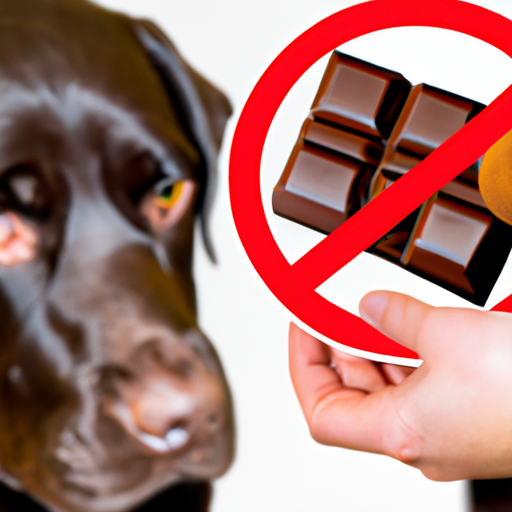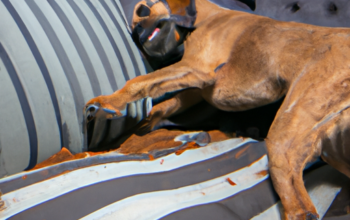Imagine Willy Wonka’s chocolate factory, a paradise for any child… or adult with a sweet tooth. However, this world of cocoa indulgence represents a menacing danger to your furry best friend.
You’ve probably heard that chocolate is bad for dogs, but do you know why? It’s all down to theobromine, an alkaloid compound found in cacao plants. This stimulant is harmless to humans but can be deadly for our canine companions. Ingesting even small quantities of chocolate can lead to symptoms like vomiting and diarrhea, while higher doses could prove fatal.
This article will provide vital information on recognizing signs of chocolate poisoning in dogs and what action to take if your pet has consumed it. Additionally, we’ll offer tips on preventing such accidents from happening and suggest alternative treats that are safe for your dog’s consumption.
Because sometimes, love means saying no to sharing that last piece of Hershey’s bar.
Understanding the Dangers of Theobromine
You may not know it, but theobromine, a compound found in chocolate, can be lethal to your beloved dog. It can cause heart problems and even seizures. This bitter alkaloid is also present in other Theobromine sources like tea leaves and cola nuts.
Dogs are particularly sensitive because they metabolize theobromine much slower than humans. This slow Theobromine metabolism allows it to build up in their system to potentially harmful levels.
In large enough quantities, the stimulant effects of this compound can result in symptoms ranging from nausea and restlessness to life-threatening cardiac arrhythmias or central nervous system dysfunction. Hence, it’s critical you keep these foods out of your pet’s reach and ensure they consume only dog-safe treats.
Recognizing Signs of Chocolate Poisoning in Canines
While the sweet treat may delight our taste buds, it’s a different story for our furry friends. Certain symptoms such as vomiting, diarrhea, rapid breathing, and seizures can be indicative of the poison taking hold. These signs can appear within 6 to 12 hours after your dog has consumed chocolate – this is known as the ‘Symptom Timeline’.
It’s important to monitor these symptoms closely and seek emergency care immediately if they persist or worsen. Rapid heart rate or restlessness could also suggest that your dog has ingested a harmful amount of chocolate. No matter how mild the symptoms might seem initially, always consult with a veterinary professional promptly. Remember: swift action is essential in treating chocolate poisoning in dogs.
What to Do When Your Pet Ingests Chocolate
Should your furry friend sneak off with a sinful sweet treat, don’t panic – there are steps to take that can help safeguard their health.
First and foremost, call your vet or an emergency pet poison hotline immediately. Provide them with as much information about the chocolate and how much was consumed.
If it’s within two hours of ingestion, your vet might recommend inducing vomiting at home using hydrogen peroxide. However, this should only be done under professional guidance.
In severe cases, Emergency Vet Visits will be necessary for Canine Stomach Pumping or administration of activated charcoal to prevent further absorption of toxins.
Remember: rapid response is crucial when dealing with chocolate poisoning in dogs. The sooner treatment starts, the better chance your pup has for a full recovery.
Preventing Chocolate Accidents
Prevention, as they say, is always better than cure and it’s no different when it comes to keeping our furry friends safe from harmful delights. Accidental ingestion prevention is an essential part of canine diet control.
-
Keep chocolate out of reach: Dogs are curious animals and will sniff out anything that smells good. Ensure all chocolates are stored in high places or sealed containers.
-
Educate family members and visitors: Make sure everyone understands the dire consequences if your dog consumes chocolate. A little awareness can go a long way in preventing accidents.
-
Monitor your dog during parties or gatherings: With more people around, there’s a higher risk of someone accidentally dropping food.
Implementing these measures ensures that your pup stays healthy and happy – free from the dangers of chocolate poisoning.
Alternative Treats for Your Furry Friend
You’re probably wondering what safe and scrumptious alternatives you can offer your lovable pet, aren’t you? It’s crucial to find Healthy Dog Snacks that won’t harm their health like chocolate does.
Here are a few Homemade Treat Recipes for your furry friend:
| Snack | Ingredients | Preparation |
|---|---|---|
| Carrot Sticks | Fresh Carrots | Peel and cut into sticks |
| Peanut Butter Biscuits | Whole wheat flour, peanut butter, eggs, water | Mix all ingredients, roll out dough, cut into shapes, bake at 350°F for 20 minutes |
| Rice Cakes | Brown Rice Flour, Water | Mix together to form dough. Roll out and cut into circles. Bake at 300°F for about an hour |
These treats will surely make your dog’s tail wag and are healthy options compared to harmful chocolate.
Frequently Asked Questions
How much chocolate can a dog ingest before it becomes dangerous?
“Isn’t it alarming how little chocolate can harm a dog? Even small amounts can trigger chocolate toxicity symptoms. Treatment options depend on timely intervention. It’s crucial to consult a vet immediately if ingestion is suspected.”
Is white chocolate as harmful as dark chocolate for dogs?
White chocolate ingredients are less harmful to dogs than dark chocolate. Canine digestive responses vary, but generally, the low levels of theobromine in white chocolate cause fewer symptoms compared to darker varieties.
How quickly can chocolate affect a dog after consumption?
Chocolate’s effects on your dog can start within an hour of consumption. Emergency responses are crucial, as early treatment options like inducing vomiting can greatly improve your pet’s chances of a full recovery.
Are certain breeds more susceptible to chocolate poisoning than others?
In breed sensitivity analysis, there’s no evidence that particular breeds are more prone to chocolate poisoning. However, poisoning symptom differences may occur due to each dog’s size, health condition, and the amount consumed.
Can dogs develop an immunity to chocolate over time if they consume small amounts regularly?
Just like Superman’s vulnerability to Kryptonite, dogs can’t develop a ‘Chocolate Tolerance’ or immunity over time. Regular exposure won’t result in ‘Immunity Building’, but rather may lead to severe health problems.
Conclusion
So, how badly can a little chocolate really harm your dog? Quite significantly, it turns out. Theobromine in chocolate is toxic to your furry friend and could lead to severe consequences. If accidental ingestion occurs, act swiftly by contacting a vet. Prevention is always best; keep chocolate out of reach and offer dog-friendly treats instead. Educating yourself about this hazard can save your pet’s life – isn’t that worth it?



